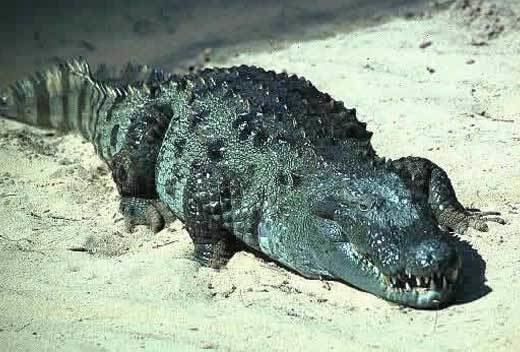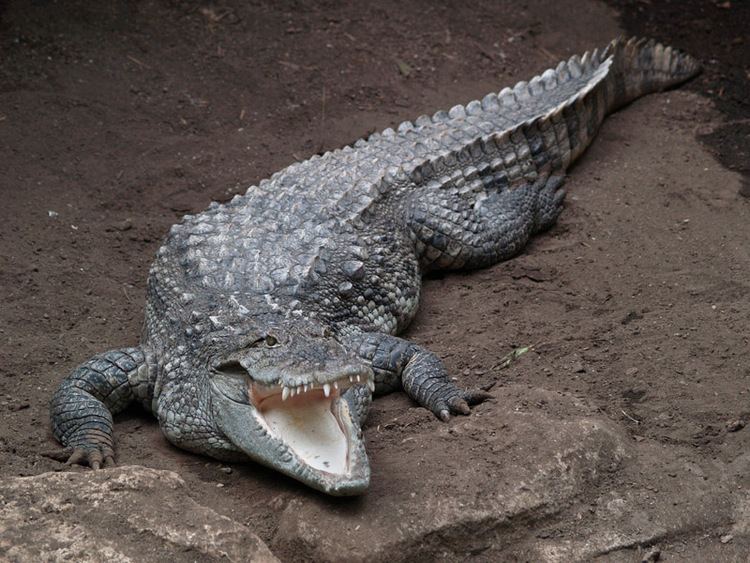Subfamily Crocodylinae Rank Species | Phylum Chordata Family Crocodylidae Mass Male: 40 – 200 kg (Adult) Higher classification Crocodylus | |
 | ||
Speed 16 – 19 km/h (Adult, In Short Bursts, Swimming) Length Male: 3.2 m (Adult), Female: 2.4 m (Adult) Similar Crocodile, Crocodylus, Gharial, Reptile, Crocodiles | ||
Realm of the mugger crocodile nature documentary
The mugger crocodile (Crocodylus palustris = "crocodile of the marsh"), also called the Indian, Indus, Persian, Sindhu, marsh crocodile or simply mugger, is found throughout the Indian subcontinent and the surrounding countries, like Pakistan where the Indus crocodile is the national reptile of Pakistan. It is one of the three crocodilians found in India, the others being the gharial and the saltwater crocodile. It is a medium-sized crocodile that mostly inhabits freshwater lakes, ponds, sluggish rivers, swamps and marshes. Males of the species are said to grow up to 4–5 m (13–16 ft) in length. As with other crocodilians, females are smaller. The mugger crocodile has the broadest snout of any extant crocodile, giving it an alligator-like appearance. It is a more heavily armored species with enlarged scutes around the neck. Adults are dark grey or brown, while hatchlings are tan colored.
Contents
- Realm of the mugger crocodile nature documentary
- Taxonomy and etymology
- Characteristics
- Size
- Distribution and habitat
- Biology and behavior
- Hunting and diet
- Tool use
- References

The mugger crocodile is a skilled predator that preys on a variety of species. Like other crocodilians they are ambush hunters and wait for their prey to come close. They wait camouflaged in the murky waters to launch the attack in the suitable moment. They mostly prey on fish, reptiles, birds and mammals. Reproduction takes place in winter months. Females lay eggs in nests that are holes dug in the sand. Temperature during incubation is the determinant of sex in the young. The mugger crocodile possesses the size to be a serious threat to humans but are not as aggressive as some other species, such as the sympatric saltwater crocodiles. They are also observed to usually avoid areas with saltwater crocodiles. Muggers are fairly social species and tolerate their conspecifics during basking and feeding.

Taxonomy and etymology

The name "mugger" is a borrowing of Hindi magar. This is in turn derived from Sanskrit makara "crocodile; mythical water monster; sign of the zodiac".
Characteristics

Mugger crocodiles have 19 upper teeth on each side; a snout that is 1⅓ to 1½ as long as broad at the base; a rough head but without any ridges; mandibular symphysis extending to the level of the fourth or fifth tooth; pre-maxillo-maxillary suture, on the palate, transverse, nearly straight, or curved forwards; and nasal bones separating the pnemaxillaries above. Four large nuchals forming a square, with a smaller one on each side; two pairs of smaller nuchals on a transverse series behind the occiput. Dorsal shield well separated from the nuchal, the scutes usually in 4, rarely in 6, longitudinal series, those of the two median usually considerably broader than long; 16 or 17 transverse series. Scales on limbs keeled. Fingers webbed at the base; outer toes extensively webbed. A serrated fringe on the outer edge of the leg. Adult blackish olive above: young pale olive, dotted and spotted with black.
Size

The mugger crocodiles is considered a medium-sized species, said to grow up to 4–5 m (13–16 ft) long. The males are larger than females, averaging 3.2 m (10 ft) compared to 2.45 m (8.0 ft) in females. Sexual maturity is obtained at around 1.7–2 m (5.6–6.6 ft) and 2.6 m (8.5 ft) for females and males respectively. The largest specimen in the British Museum measures 3.7 m (12 ft).
Distribution and habitat
The mugger crocodile can be found in India, Bangladesh, Sri Lanka, Pakistan, Nepal, the southern tip of Iran, and probably in Indo-China and at one point, even in Southern Iraq. The mugger is the only crocodilian found in Iran and Pakistan. This crocodile is the most common and widespread of the three species of crocodiles in India, far outnumbering the much larger saltwater crocodile within the country (and most likely within neighboring countries).
In the 1980s, the largest population of wild crocodiles in Tamil Nadu, South India lived in the Amaravathi Reservoir, and in the Chinnar, Thennar and Pambar rivers that drain into it. Their total population here was estimated to be 60 adults and 37 sub-adults. The Amaravati Sagar Crocodile Farm, established there in 1975, is the largest crocodile nursery in India. Eggs are collected from wild nests along the perimeter of the reservoir to be hatched and reared at the farm. There were up to 430 animals maintained in captivity at one time. Hundreds of adult crocodiles have been reintroduced from here into the wild. The estimated population in Pakistan is between 400 and 450 animals found in the coastal areas and rivers of Sindh and Baluchistan. The estimated number of animals in Sindh in 160, while in Balochistan the estimated number is 64, while only 24 were seen there, sources in the Sindh Wildlife Department said, requesting anonymity.
On the Iranian Makran coast, above Chabahar are found around 200 mugger corocodiles. They are indigenous to the Sarbaz River, Bahu Kalat River, Kaju and Pishin river basins in Baluchistan province. Due to human activities and that long drought of the late 1990s, early 2000s, the mugger has been pushed to the brink of extinction over the past few years. Following several tropical cyclones, such as the Cyclone Gonu and Cyclone Yamyin in 2007, and Cyclone Phet in 2010, much of the habitat of the Iranian mugger crocodiles has been restored as the dry lakes and hamuns have flooded once again. The animal is known as gando in the local Iranian vernaculars.
The mugger crocodile is a freshwater species found in lakes, rivers and marshes. Muggers prefer slow-moving, shallower bodies of water rather than, fast-flowing, deep areas. They are also known to thrive in man-made reservoirs and irrigation canals. Although it prefers freshwater, it has some tolerance to saltwater therefore is occasionally reported from saltwater lagoons. It is sympatric with the gharial (Gavialis gangeticus) in some areas of India and Nepal and with the saltwater crocodile (Crocodylus porosus) in other areas, but separated by habitat most of the time. It is adapted to terrestrial life like its cousin, the Cuban crocodile, more than most crocodilians, but is ecologically most similar to the African Nile crocodile. It is known to be more mobile on land, can migrate considerable distances over land in search of a more suitable habitat. It can chase prey on land for short distances. They are also known to dig burrows as shelters during the dry seasons.
Biology and behavior
Mugger crocodiles can achieve speed of around 8 mph over a short distance in pursuit of prey. They can swim much faster than they can run—achieving speeds of 10 to 12 mph in short bursts—and can cruise at about 1 to 2 mph.
Hunting and diet
Being a large carnivorous reptile, the mugger crocodile eats fish, snakes, turtles, birds and mammals. The mammalian prey are usually small to medium-sized, such as monkeys, squirrels, chital and otters. In fact, most vertebrates that approach to drink are potential prey, and may suffer being seized and dragged into the water to be drowned and devoured when the opportunity arises. Large adults will sometimes prey on larger mammals, such as large deer, like sambar, and large bovines, like cattle and domestic water buffalo, but such large prey are not common prey as in the case of sympatric saltwater crocodiles. At night, they sometimes hunt on land, lying in ambush near forest trails. During these nocturnal hunts, they often steal kills from other predators, such as leopards, sometimes preying on the predators as well. This species is generally considered to be occasionally dangerous to humans, but nowhere near as notorious as the much larger (and, in India, less common) saltwater crocodile.
Tool use
Mugger crocodiles have been documented using lures to hunt prey such as birds. This means they are among the first reptiles recorded to use tools. By balancing sticks and branches on their heads, Mugger crocodiles are able to lure birds looking for suitable nesting material. This strategy, which is shared by the American alligator, is particularly effective during the nesting season, in which birds are more likely to gather appropriate nesting materials.
